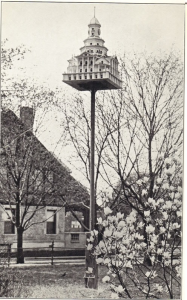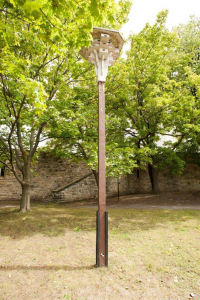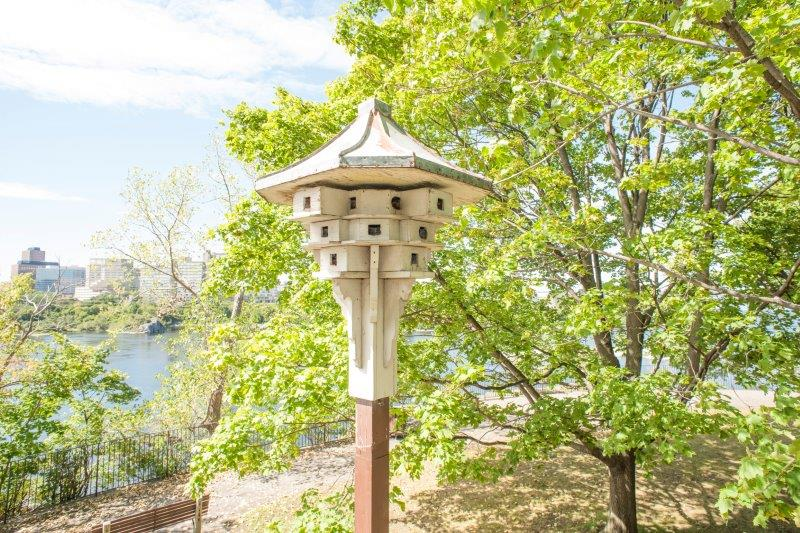Can you help us solve another martin mystery?

Earlier martin houses came in many elaborate styles. Interestingly, Henry Ford had a strong interest in birds and purchased many of these 1920s style martin mansions from
J. Warren Jacobs’ company for his Fair Lane estate in Michigan.

Megan McIntosh, Purple Martin Project Coordinator
Purple Martins are social, colonial birds. They have a very interesting relationship with humans that dates back centuries. It is believed that before Europeans arrived in North America, some First Nations people hung up hollowed out gourds (similar to a pumpkin) to encourage Purple Martins to nest near their settlements, and Europeans continued this tradition. Putting up these martin houses was so common that east of the Rocky Mountains, Purple Martins had become entirely dependent on these special birdhouses that people provide for them. In John J. Audubon’s (American ornithologist, naturalist, and painter) world renowned book, Birds of America (Published between 1827 and 1838), he remarked “All our cities are furnished with houses for the reception of these birds”.
Today, we still enjoy this tradition that began with First Nations. Unfortunately, Purple Martins and related species (aerial insectivores including swallows, swifts, nightjars and flycatchers) are declining rapidly throughout most of their range. The main cause of this decline is a bit of a mystery – it could be a combination of factors such as climate change, habitat loss, pesticides that reduce insect food, and industrial activity. It could be related to their breeding grounds, their wintering grounds, their migratory routes or combinations of the three. Fortunately, passionate researchers and naturalists across the Americas are working hard to uncover the causes and identify solutions to help recover these species’ populations.
Perhaps you can help us find out more about this other little martin mystery?
 Recently, we have discovered a unique Purple Martin house nestled between the trees in a public park that overlooks the Ottawa River – even though our Nature Canada office is only a five minute walk away!
Recently, we have discovered a unique Purple Martin house nestled between the trees in a public park that overlooks the Ottawa River – even though our Nature Canada office is only a five minute walk away!
Currently, the house appears to be only used by a few starlings. Sources say that it housed Purple Martin colonies as recent as the 1990’s and was erected sometime in the 1960’s. The tiered system sits atop a five meter high post with approximately 28 individual wooden compartments that are painted white. The hexagonal metal clad roof and decorative brackets add to the structures distinctive charm. Overall, the house is quite weathered, the paint is peeling and rust is evident on the roof. The entrance holes to the nesting cavities appear to have been crudely enlarged from the original design and vary in size to each entrance.
We are curious! Not much is known about the origins of this house. Who installed it? How old is it really? Is it a custom built house or a popular model from a specific time? Who maintained it and why were the entrances altered?
Can you help us solve the mystery of the Cliff Street Park Purple Martin house?
If you can, please email Megan, our Purple Martin Project Coordinator, with the subject “Purple Martin mystery on the Hill”.
[one_half][/one_half] [one_half_last]

An interesting Purple Martin house located in a public park tucked away behind the Supreme Court of Canada in Ottawa.
[/one_half_last]




